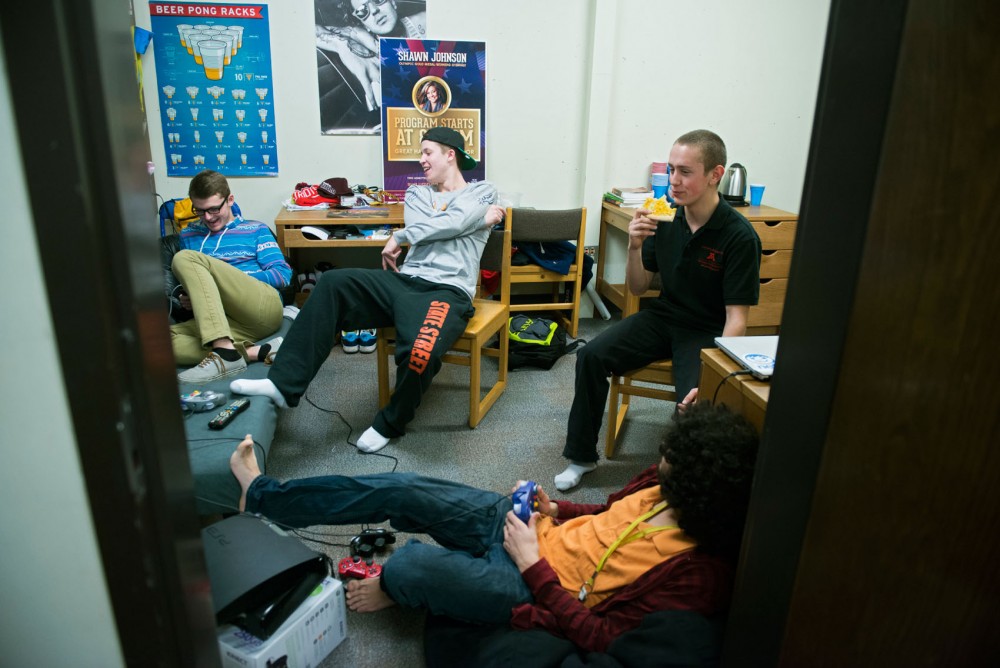As a freshman living in Bailey Hall on the St. Paul campus, biochemistry freshman Marty Gliva is surrounded by men.
This has more to do with the layout of Bailey than Gliva’s choice: Every floor of the hall is split in half by gender.
Gliva said his mostly male group of friends is probably the result of his residence hall’s floor plan.
“All the guys that I talk to on a daily basis are either from my high school or on the same floor as me,” he said.
Residence hall students at the University of Minnesota face a situation similar to Gliva, as their room assignments may
determine the people they’ll spend the most time with.
University Housing and Residential Life divides genders in residence halls according to the bathrooms available, said Mannix Clark, associate department director for HRL.
“We try to integrate [genders] when we can,” Clark said, though the bathroom availability in different halls can make this a challenge.
“It just really depends on the type of housing that you have to work with,” he said.
Clark said studies have shown students living in close proximity to the opposite gender acclimate to college better than students living in same-gender housing.
Though University apartments like Roy Wilkins Hall and Yudof Hall don’t allow more than one gender in each unit, Clark said students have expressed interest in having this policy changed.
Housing and Residential Life may look into lifting this restriction in the future, Clark said.
Since Housing and Residential Life relies on student finance, he said students play a big role in determining what changes it will make.
“You’ve got to change how the students change, because what you don’t want is open beds,” he said. “If the students are telling us, ‘Hey we want to do something different,’ we try at least to be there when it’s within reason with what we could do.”
Living in close proximity to the other gender can be an important part of the college experience, said gender, women and sexuality studies professor Jigna Desai.
“This is an opportunity to live next door to someone that you might not have gotten a chance to live next door to,” Desai said.
Living with people from the same gender can have both positive and negative results, she said.
“Sometimes homo-social kinds of environments can be really supportive,” she said, “and sometimes they can be ways in which privilege and even misogyny can get fostered.”
Desai mentioned fraternities as a potentially healthy and supportive environment for men that could also possibly expose them to competition and gender stereotypes.
She said this could just as easily apply to women living together, too.
“Sometimes women are meanest to each other,” Desai said.
Computer science and art freshman Nicole Zhang spent most of last semester living in expanded housing with six other girls in Centennial Hall.
The girls Zhang lived with served as her main group of friends at the beginning of the year, she said, and she hung out with far more girls than guys.
She said residence hall students’ social lives have a lot to do with where they end up.
“I think it does have to do with how it’s laid out,” she said. “[It’s] easier getting along with your immediate neighbors — all the girls in my case.”
Though she said she got along with her roommates at the beginning of the semester, living with so many girls proved to be difficult as time went on.
“It’s six girls, six different schedules, six girls with PMS,” she said. “I personally got a little tired of it because we never got any privacy at all.”
In the renovated part of Sanford Hall, biology sophomore Vladimir Petrenko lives in a co-ed wing. His group of friends has almost an equal number of girls and guys, he said.
Living in a co-ed wing, Petrenko said, makes for more gender interaction than on gender-separated floors of Sanford.
“We get a huge compilation of people just walking by,” he said. “It’s very sociable, at least where I live.”
Petrenko said though it’s important for women and men to interact in the dorms, it can hinder students’ studying.
“After all,” he said, “you are going to school for education, and having too many distractions can cause a decrease in focus.”
Freshman Eva Thomas, who lives near Petrenko in Sanford, said she really likes living on the co-ed floor.
“It makes a more balanced environment,” Thomas said. “Usually, you first try to make good girl friends, but then if you have the guys there then you make really good guy friends, too, at the same time.”


